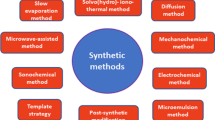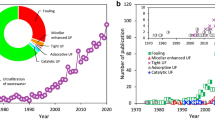Abstract
This research was conducted aimed to investigate the performance of mixed matrix membranes including polysulfone (PSF) and poly (ether sulfone) (PES) as polymers and cooper (II)-benzene-1, 3, 5-tricarboxylate (Cu-BTC) as filler with different blend ratios. The response surface methodology (RSM) was employed to design the experiments. The permeation of CO2 and CH4 gases was measured at a feed pressure of 3–9 bar. Morphology, thermal stability, spectral properties and mechanical properties of the membranes were evaluated by SEM, TGA, FTIR, XRD and tensile tests, respectively. According to the results, an increase in the pressure led to a gradual fall in the permeability of CO2 and CH4. Thermal and mechanical stability of the membranes increased by the addition of nanoparticles and polymers to the pure PSF and PES membranes, molecular interaction between the two polymers and MOF was observed by FTIR analysis. The morphology of the membranes was homogenous and good disperse of MOF in matrix polymer. Gas permeability studies indicated that the permeation and ideal selectivity were improved by 100% and 34% with the addition of the Cu-BTC (20%) and PES (73%) in the PSF matrix. It was concluded that synthesized PSF/PES/CUBTC mixed matrix membranes provided an optimized performance with a good combination of permeability, selectivity.







Similar content being viewed by others
References
Shahid S, Nijmeijer K (2014) Performance and placticization behavior of polymer-MOF membranes for gas separation at elevated pressure. J Membr Sci 459:166–177
Waheed N, Mushtaq A, Tabassum S, Gilani MA, Ilyas A, Ashraf F, Jamal Y, Bilad MR, Khan AU, Khan AL (2016) Mixed matrix membranes based on polysulfone and rice husk extracted silica for gas separation. J Sep Purif Technol. 170:122–129
Azizi N, Mohammadi T, Mosayebi Behbahani R (2017) Synthesis of a new nanocomposite membrane (PEBAX-1074/PEG-400/TiO2) in order to separate CO2 from CH4. J Nat Gas Sci Eng 37:39–51
Guillen GR, Pan Y, Li M, Hoek EM (2011) Preparation and characterization of membranes formed by nonsolvent induced phase separation: a review. Ind Eng Chem Res 50(7):3798–3817
Perez EV, Balkus J Jr, Ferraris JP, Musselman IH (2009) Mixed matrix membranes containing MOF-5 for gas separation. J Membr Sci 328:165–173
Tavasoli A, Feijani EA, Mahdavi H (2015) Poly (vinylidene fluoride) based mix matrix membranes comprising metal organic frame works for gas separation application. Chem Eng Res Des. https://doi.org/10.1016/j.cherd.2015.02.009
Diaz K, Gonzalez ML, Castillo LF, Riand E (2011) Effect of zeolitic imidazolate frameworks on the gas transport performance of ZIF8-poly (1, 4-phenylene ether-ether-sulfone) hybrid membranes. J Membr Sci 383:206
Chen K, Kai Xu LX, Xiao Dong YH, Chongqing Wang LBS, Yichang P (2018) Enhanced CO2/CH4 separation performance of mixed-matrix membranes through dispersion of sorption-selective MOF nanocrystals. J Membr Sci. https://doi.org/10.1016/j.memsci.2018.06.007
Dorosti F, Alizadehdakhel A (2018) Fabrication and investigation of PEBAX/Fe-BTC a high Permeable and CO2 Selective mixed matrix membrane. Chem Eng Res Design 136:119–128. https://doi.org/10.1016/j.cherd.2018.01.029
Ibrahim BA, Kadum KM (2010) Influence of Polymer blending on mechanical and thermal properties. Mod Appl Sci 4(9):157–161
Kiadehi AD, Rahimpour A, Jahashahi M, Goreyshi AA (2015) Novel carbon nano-fiber (CNF)/polysulfone (PSF) mixed matrix membranes for gas separation. J Ind Eng Chem 22:199–207
Hafiz AM, Hilmi M, Maizatual SS, Mohd RO, Thanabalan M (2015) Polysulfone/poly (ether sulfone) blended membranes for CO2 separation. J Appl Polym. https://doi.org/10.1002/app.42946
Ghadimi A, Amirilargani M, Mohammadi T, Kasiri N, Sadatnia B (2014) Preparation of alloyed poly (ether block amide)/poly (ethylene glycol diacrylate) membranes for separation of CO2/H2 (syngas application). J Membr Sci 458:14–26
Dorosti F, Omidkhah MR, Abedini R (2014) Fabrication and characterization of matrimid/MIL-53mixed matrix membrane for CO2/CH4 separation. Chem Eng Res Des 92:2439–2448
Qu P, Tang H, Zhang L, Wang S, Gao Y (2010) Polyether sulfone composite membrane blended with cellulose fibrils. Bio Res 5(4):2323–2336
Kusworo TD, Ismail AF, Mustafa A, Li K (2008) The effect of type zeolite on the gas transport properties of polyimide-based mixed matrix membranes. Reaktor 12(2):68–77
Zhang Y, Musselman IH, Ferraris JP, Balkus KJ Jr (2008) Gas permeability properties of matrimid membranes containing the metal-organic framework Cu-BPY-HFS. J Membr Sci 313:170–181
Sadeghi M, Semsarzadeh MA, Moadel H (2009) Enhancement of the gas separation properties of polybenzimidazole (PBI) membrane by incorporation of silica nano particles. J Membr Sci 331:21–30
Li H, Freeman BD, Ekiner OM (2011) Gas permeation properties of poly(urethane-urea)s containing different polyether’s. J Membr Sci 369:49–58
Yong WF, Li FY, Xiao YC, Li P, Promoda KP, Tong YW, Chung TS (2012) Molecular engineering of PIM-1/matrimid blend membranes for gas separation. J Membr Sci 407–408:47–57
Moradihamedani P, Ibrahim NA, Yunus WMZW, Yusof NA (2013) Separation of CO2 from CH4 by pure PSF and PSF/PVP blend membranes: Effects of type of non solvent, solvent, and PVP concentration. J Appl Polym 130:1139
Nasir R, Mokhtar H, Man Z, Dutta BK, Shaharun MS, Abu Bakar MZ (2015) Effect of fixed carbon molecular sieve (CMS) loading and various Di-ethanolamine (DEA) concentrations on the performance of mixed matrix membrane for CO2/CH4 separation. J Membr Sci 352:126
Acknowledgement
The support of Islamic Azad University, Rasht branch is highly acknowledged.
Author information
Authors and Affiliations
Corresponding author
Additional information
Publisher's Note
Springer Nature remains neutral with regard to jurisdictional claims in published maps and institutional affiliations.
Rights and permissions
About this article
Cite this article
Asadi, H., Alizadehdakhel, A., Ramazani, A. et al. The effect of Cu-BTC metal–organic framework (MOF) in mixed matrix membranes on permeability and separation of carbon dioxide and methane. Polym. Bull. 78, 6953–6968 (2021). https://doi.org/10.1007/s00289-020-03459-y
Received:
Revised:
Accepted:
Published:
Issue Date:
DOI: https://doi.org/10.1007/s00289-020-03459-y




